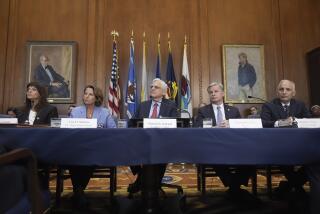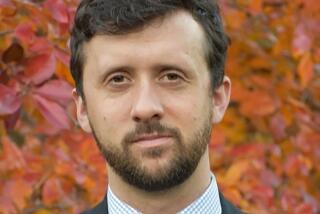Friendly Soviets Roll Out Red Carpet for Americans
- Share via
MOSCOW — American correspondents who were once derided here as “bourgeois scribblers” and “pen gangsters” today are being invited to write guest columns for the government newspaper Izvestia and other publications.
American businessmen formerly accused of seeking “profits at any price, even at the price of human lives,” are being assiduously courted by Soviet firms eager to go into partnership with them.
The U.S. Embassy, which less than five years ago was routinely branded as a nest of spies and was avoided by all but the most official or desperate of Soviets, has become the hub of a busy bilateral social life.
All this reflects the change that the “new thinking” in Kremlin foreign policy has wrought in day-to-day life for Americans here--change that is particularly stunning to those who were around in the bad old days.
“Four-fifths of what I do wasn’t even in the job description three years ago,” said Philip C. Brown, the embassy’s press and cultural affairs counselor. He is back in Moscow for a second tour after having served here in the late 1970s as a junior officer.
Just last week, for example, most of the Moscow Philharmonic Orchestra showed up at the embassy’s theater, with spouses, for the premier of “Maestros in Moscow,” a video concert of American and Soviet compositions narrated by actor Gregory Peck. Such an evening would have been inconceivable a few years ago, conductor Dmitri Kitayenko said.
The next night, Ambassador Jack F. Matlock Jr., an accomplished linguist and expert in Soviet literature, was host at a poetry reading for Soviet and other guests at Spaso House, the ambassador’s residence. And the day afterward, Matlock gave an unprecedented background briefing, in Russian, for the Soviet press.
Elsewhere in Moscow last week, a group of Soviet and American experts met for several days to discuss terrorism. Another group, made up of participants on all three sides--Cuba, the United States and the Soviet Union--of the 1962 Cuban Missile Crisis, gathered in the hope of learning more about how to avoid a future confrontation.
At the famous Tretyakov Gallery, Soviets flocked to see a photo exhibit marking the centennial of America’s National Geographic Society.
It all adds up, Matlock has said, to “the most intense relationship since the (World War II) alliance.”
Not Like London, Paris
Of course, Americans are not likely to confuse Moscow with London or Paris. If anything, the Soviet capital appears to have deteriorated physically in the last decade. There seems to be even less available in the stores.
Work for most Americans here has become more demanding than it used to be, if only because it is possible to do so much more. Conversely, socializing within the American community has suffered.
Almost all Westerners here are still required to live either in an embassy complex or in a special apartment block for foreigners, where it is assumed that, glasnost or not, the telephones and walls are still bugged. And while the Soviets are permitting much more travel by Americans outside of Moscow than they used to, widespread restrictions continue.
Nonetheless, the psychological climate has been transformed.
What used to be routine harassment of Americans has all but disappeared, U.S. officials say. A favorite target, besides the correspondents, used to be the Russian-speaking guides who accompanied American exhibits as they moved from city to city. There would be bomb scares and formal complaints to the embassy that the guides had somehow misbehaved.
By contrast, an ambitious 18-month, nine-city computer exhibit called “Info, USA” just ended without “a single serious problem,” an official said.
“I don’t consider this pure luck,” the official said. “It was not in the Soviet game plan to make life difficult for us.”
The harassment also seems to have ended for Soviets who associate with Americans. Scores of Soviets now congregate around the embassy every working day, applying for an emigration or visitor’s visa to the United States.
A diplomat, referring to the Soviet guards outside the embassy, remembered watching more than once on an earlier tour as “people got dragged off by the hair to the ‘beat-up’ shack around the corner” for doing the same thing. Now, he said, “we have basically a cooperative effort with the cops” to process the applicants as efficiently as possible.
The most incongruous presence at the “Maestros in Moscow” gathering the other night was not the standard Soviet guard at the embassy gate but the grim-faced U.S. Marine in battle fatigues at the theater entrance, presumably to make sure no Soviet musician tried to get in through the wrong door.
Most Soviets used to steer a wide course around Americans, if only because they knew it could get them in trouble with their own authorities. But no more, thanks in part to what a senior U.S. diplomat called “a fairly major” and under-appreciated shift in the way the Soviet media now treat the United States.
“There are more and more neutral, or even favorable, articles now about the way we do things,” the diplomat said.
A recent television program on the U.S. Army debunked previous Soviet reports, which depicted volunteers as unemployable addicts and killers. According to the television account, America’s shift from a conscript to a professional army had resulted in a higher-quality force.
The December issue of Vecyoli Kartinki (Merry Pictures), a children’s magazine, featured on its cover three students from the embassy-run Anglo-American school, and the issue was devoted entirely to American children’s literature.
Perhaps more significant than the image of America presented by Soviet journalists is the fact that the authorities are offering ever-increasing avenues for Americans to tell their own story.
The Soviet press now carries frequent articles by well-known Americans explaining U.S. policies and trends. Matlock has more Soviet interview requests than he has time to fill, and two junior embassy officers have been invited to answer listeners’ questions on a radio call-in program next month.
Not only have the Soviets stopped jamming the Voice of America and Radio Liberty, the Western radio stations that are heard by millions here, but the media even praised Radio Liberty’s coverage of last month’s Armenian earthquake as superior to Radio Moscow’s. This is a station that used to be funded by the CIA and was for a long time at the top of the Soviet broadcast enemies list.
The U.S. Information Agency’s Russian-language magazine, Amerika--which the Soviet authorities used to return by the thousands, alleging that nobody wanted to read them--has just seen its circulation rise by a third, to 80,000 copies a month. And the Soviets have agreed to take 120,000 a month in 1991.
There are so many noteworthy Americans visiting the Soviet Union these days that many are virtually ignored, as unexceptional and less interesting than the daily drama of perestroika , the restructuring of the Soviet system. A visiting American governor who showed up for a photo opportunity at the Anglo-American school was taken aback when no press showed up.
“What’s wrong?” the governor asked. “Where are they?”
A teacher shrugged and told him that such an appearance “is just not news any more.”
It is not the officials but the more ordinary Soviet and U.S. citizens who are meeting one another, and this makes the present situation different from past flurries of improved Soviet-American relations, Alexander Churlin, deputy chief of the Soviet Foreign Ministry’s Department of Cultural Relations, said in an interview.
“We mean to involve as many people as possible in these exchanges,” he said, “people who represent themselves rather than any government organization.”
The first group of about 40 Soviet high school students are now in the United States as part of an exchange program expected to involve more than 1,000 students a year on each side by 1992.
“What’s more,” Churlin said, “the participants in such exchanges are no longer living in isolated condominiums.”
They will be staying with families, just as 200 Americans on a different exchange program last year stayed with families in the Soviet republic of Georgia.
It used to be that Soviet officials seemed intent mostly on hiding their society from Americans. Now, Churlin said, “in this time of glasnost we are seeking to increase contacts so we can expose Americans to these changes.”
Expanding Soviet-American contacts are easing tension in both countries, he said, and added: “I talk a lot to Soviets who visit America. They tell me they are observing colossal changes in American attitudes compared with what they saw in the early 1980s. The enemy image that existed widely among Americans is gone. And the same thing is happening among Soviet people.”
Churlin said he is confident that this burst of diplomatic warmth will not go the way of the detente of the early 1970s.
“As for the Soviet Union,” he said, “we believe this is an irreversible process, because it is tied to our internal process of democratization and openness.”
But others fear that these processes themselves could be reversed if President Mikhail S. Gorbachev falters. A U.S. diplomat with several years of experience here asked rhetorically: “Is this all too good to be true? Are there no dark clouds?”
Then, answering his own question, he went on:
“This really has not become Western Europe. There are bound to be problems. But it’s my opinion that those elite Soviets (who have benefited the most from Gorbachev’s attempts to open up the society) have had too much of a taste of this to see everything turn around and go back to where it was.”
Times London bureau chief Dan Fisher, now on assignment in Moscow, was The Times’ Moscow bureau chief from June, 1977, until August, 1980.
More to Read
Sign up for Essential California
The most important California stories and recommendations in your inbox every morning.
You may occasionally receive promotional content from the Los Angeles Times.










